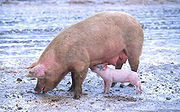by
Barbara Kram, Editor | April 24, 2009

Swine flu is not contained
to those in proximity to pigs
An outbreak of swine flu in Mexico is causing health officials concern. Public places in Mexico have been closed to prevent spread of the contagious illness. The virus may have mutated to a strain for which the public has little immunity. Several dozen deaths in Mexico are attributed to the outbreak.
In late March and early April 2009, cases of human infection with swine influenza A H1N1 viruses were first reported in Southern California and near San Antonio, Texas. CDC and local and state health agencies are working together to investigate this situation. Eight cases have been recorded so far in the U.S.
CDC has issued guidance for residents and health care professionals including clinicians, state public health laboratories, and public health/animal health officials. (Link below.)



Ad Statistics
Times Displayed: 79541
Times Visited: 2807 Ampronix, a Top Master Distributor for Sony Medical, provides Sales, Service & Exchanges for Sony Surgical Displays, Printers, & More. Rely on Us for Expert Support Tailored to Your Needs. Email info@ampronix.com or Call 949-273-8000 for Premier Pricing.
CDC has determined that this virus is contagious and is spreading from human to human. However, at this time, it not known how easily the virus spreads between people. As with any infectious disease, CDC recommends precautionary measures for people residing in these areas.
The symptoms of swine flu in people are similar to the symptoms of regular human flu and include fever, cough, sore throat, body aches, headache, chills and fatigue. Major U.S. outbreaks occurred in 1918 and 1976.
According to CDC, swine Influenza (swine flu) is a respiratory disease of pigs caused by type A influenza viruses. Outbreaks of swine flu happen regularly in pigs. People do not normally get swine flu, but human infections can and do happen. Most commonly, human cases of swine flu happen in people who are around pigs but it's possible for swine flu viruses to spread from person to person also.
Must-read information and precautions are at:
http://www.cdc.gov/flu/swine/investigation.htm

